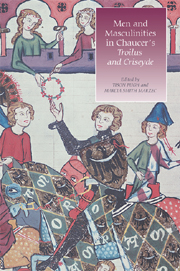Book contents
- Frontmatter
- Contents
- Contributors
- Abbreviations
- Introduction: The Myths of Masculinity in Chaucer's Troilus and Criseyde
- 1 “Beautiful as Troilus”: Richard II, Chaucer's Troilus, and Figures of (Un)Masculinity
- 2 The State of Exception and Sovereign Masculinity in Troilus and Criseyde
- 3 Revisiting Troilus's Faint
- 4 What Makes a Man? Troilus, Hector, and the Masculinities of Courtly love
- 5 Masculinity and Its Hydraulic Semiotics in Chaucer's Troilus and Criseyde
- 6 Masochism, Masculinity, and the Pleasures of Troilus
- 7 “The Dreams in Which I'm Dying”: Sublimation and Unstable Masculinities in Troilus and Criseyde
- 8 “A Mannes Game”: Criseyde's Masculinity in Troilus and Criseyde
- 9 Troilus's Gaze and the Collapse of Masculinity in Romance
- 10 Sutured Looks and Homoeroticism: Reading Troilus and Pandarus Cinematically
- 11 Being a Man in Piers Plowman and Troilus and Criseyde
- 12 “The Monstruosity in Love”: Sexual Division in Chaucer and Shakespeare
- Index
- CHAUCER STUDIES
4 - What Makes a Man? Troilus, Hector, and the Masculinities of Courtly love
Published online by Cambridge University Press: 12 September 2012
- Frontmatter
- Contents
- Contributors
- Abbreviations
- Introduction: The Myths of Masculinity in Chaucer's Troilus and Criseyde
- 1 “Beautiful as Troilus”: Richard II, Chaucer's Troilus, and Figures of (Un)Masculinity
- 2 The State of Exception and Sovereign Masculinity in Troilus and Criseyde
- 3 Revisiting Troilus's Faint
- 4 What Makes a Man? Troilus, Hector, and the Masculinities of Courtly love
- 5 Masculinity and Its Hydraulic Semiotics in Chaucer's Troilus and Criseyde
- 6 Masochism, Masculinity, and the Pleasures of Troilus
- 7 “The Dreams in Which I'm Dying”: Sublimation and Unstable Masculinities in Troilus and Criseyde
- 8 “A Mannes Game”: Criseyde's Masculinity in Troilus and Criseyde
- 9 Troilus's Gaze and the Collapse of Masculinity in Romance
- 10 Sutured Looks and Homoeroticism: Reading Troilus and Pandarus Cinematically
- 11 Being a Man in Piers Plowman and Troilus and Criseyde
- 12 “The Monstruosity in Love”: Sexual Division in Chaucer and Shakespeare
- Index
- CHAUCER STUDIES
Summary
A survey of the chivalric literature contemporary with Chaucer suggests it is largely true that by Chaucer's time, “chroniclers and poets had long been recording elaborate – and contradictory – notions of what it meant to be a member of the knightly estate, notions such as that a true knight must be a lover as well as a soldier,” as Craig Berry argues. Thus, for example, Geoffroi de Charny's Book of Chivalry cites “Deeds Undertaken for love of a lady” as one method of winning “great honor” through “deeds of arms”; yet Charny also argues that “All Honors Come from God's Grace” (187), and he urges the knight to live in such a way as to please God. In contrast, the earlier, thirteenth-century anonymous ordene de Chevalerie, in recounting the advice of the fictional Hue de Tabarie to Saladin on the nature of knighthood, makes clear its position on knightly chastity, quoting the crusader:
you should preserve in holiness your pure flesh, your loins, and your whole body, and keep your name pure, as in a state of virginity. You should not practice lechery, for a knight should cherish his body and keep it pure so that he does not incur shame therefrom, for God much hates such filth. (172)
- Type
- Chapter
- Information
- Publisher: Boydell & BrewerPrint publication year: 2008

